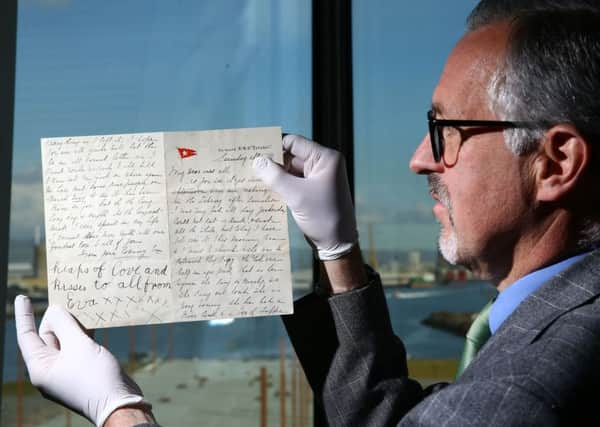Royal Mail seeking out old letters for social history project


The company, which is celebrating its 500th anniversary, hopes to unearth some untold stories around key events from the people who lived through them.
Two letters from passengers on board the ill-fated Titanic have already been submitted.
Advertisement
Hide AdAdvertisement
Hide AdThey include a note from Esther Hart and her seven-year-old daughter Eva, penned just hours before the ship sank in April 1912.


In it, Mrs Hart said they expected to arrive in New York early because of the speed at which the ship was travelling. It was found in the pocket of a coat belonging to her husband who drowned in the tragedy.
Another letter from assistant surgeon Dr John Simpson to his mother, dated April 11, 1912, describes how he was settling in well into his larger than expected cabin accommodation.
It was was brought ashore at Cobh, Co Cork, the Titanic’s last stop.
Advertisement
Hide AdAdvertisement
Hide AdTim Husbands, chief executive of the Titanic Belfast museum, said: “With both our Dr Simpson and Esther Hart letters, we see first-hand the impact of the written word over our visitors, bringing the Titanic’s story to life in a very real and emotive way.


“These letters are treasured artefacts and are of vast historical significance. They captivate our guests’ imagination as well as compliment the modern technology in our galleries.”
Archivists are particularly keen to receive documents about family; the role of women; love and friendships; travel; personal achievements and moments in history.
Letters which touch on the impact of conflict, emigration and immigration are also welcome as are notes from or about famous people and popular culture.
Advertisement
Hide AdAdvertisement
Hide AdLetters from centuries ago to the present day will be accepted.
David Gold, head of public affairs at Royal Mail, said: “Personal letters such as the letters written on the Titanic come from the heart and as a result, often tell us details that aren’t included in official documents. Our hope is that the letters and postcards people find will help us build a picture of how life really was for communities throughout the ages - warts and all.”
Lucy Worsley, TV historian, and chief curator with Historic Royal Palaces, said she was looking forward to reading all of the submissions.
She said: “One of the best bits of my work as a historian is unfolding a manuscript that no one has read in decades, if not centuries. Every aspect of doing it is a thrill, from deciphering the handwriting, right down to the fact that old documents have their own special unique smell.
Advertisement
Hide AdAdvertisement
Hide Ad“Of course, lots of the nationally important documents in our archives up and down Britain relate to nationally important events, like the Industrial Revolution or the abolition of slavery. But often legal or official documents miss out the human stories, how people were feeling about the great issues of the day. That’s something you get best from personal letters.”
Letters can be uploaded online through the web address https://letters.royalmailgroup.com. Alternatively, a photocopy can also be sent to Freepost Letters of our Lives.